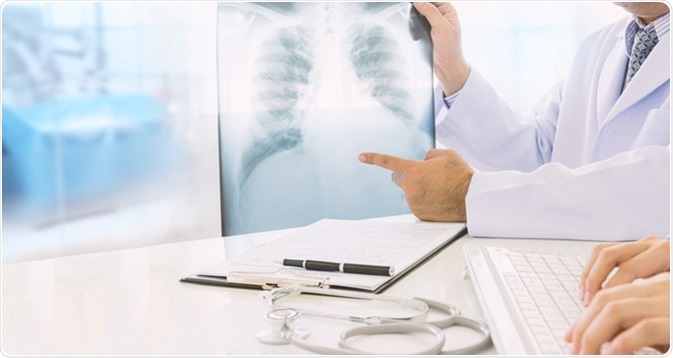Pneumonia is a respiratory illness that affects the patient’s ability to breathe easily. The air sacs in the lungs are filled up with fluid or pus when the infection strikes. This can result in symptoms such as fever, a slowly worsening cough, runny or leaky nose, and an overwhelming sense of tiredness. There are more than thirty different causes of pneumonia, resulting in different degrees of severity of the illness.

Image Credit: Create jobs 51 / Shutterstock
Complications resulting from pneumonia can prove fatal. The possible complications may include:
- Respiratory f ailure (i nability to breathe, leading to use of a ventilator)
- Acute r espiratory d istress s yndrome (s evere version of respiratory failure)
- Sepsis (i nfection of the blood which can cause organ failure)
- Lung a bscesses (l iquid inside the lung air pockets which need to be drained during surgery)
If caught in time, the illness can be treated successfully with medicines.
What is Walking Pneumonia?
A form of a typical p neumonia caused by the bacteria Mycoplasma pneumoniae is called w alking p neumonia. It is a milder form of the illness which does not exhibit very severe symptoms. The patient is often likely to mistake the symptoms for the common cold or flu.
The infection does not make the patient feel unwell to such a degree that bed rest is mandatory. The patient continues to walk and follow the daily routine, hence the name. Only one in three cases of w alking p neumonia will convert into full blown pneumonia. Often it is left untreated because it was never diagnosed .
How is Walking Pneumonia Treated?
Walking p neumonia is often not diagnosed medically. It simply runs it s course, and within a week to three weeks, is healed. However if it is diagnosed properly, the suffering of the patient can be eased greatly and the rec uperation time is shortened by antibiotics .
Should symptoms akin to the common cold or flu persist for more than a week to ten days, the patient should see a doctor . Most people are unaware of the possibility of developing w alking p neumonia and hence do not take adequate care when they contract it.
Treatment at Home
Simple measures can make it easier to deal with w alking p neumonia at home. Most patients will not have to be admitted to a hospital for treatment.
- Get lots of rest. Even when the body seems to be doing okay while coping with the symptoms, resting allows it to repair itself faster.
- Drink more fluids. The more fluids that pass through the body, the faster the toxins are flushed out from the system.
- Use heating pads. The muscle aches that accompany the illness can be eased by using warm compresses on the locally affected area.
- Steam inhalation. Placing a humidifier in the room will help, but doing actual steam inhalation with essential oils like lavender, or tea tree can ease the discomfort of the throat.
- Use medicine for controlling fever. The fever is usually low grade, but can drain the body. Keep it under control by using non-steroidal anti-inflammatory drugs (NSAIDs).
Treatment at Hospital
Should the condition of the patient deteriorate, it would be advisable to admit them to a hospital. Here’s the sort of treatment that they may be prescribed.
- Antibiotics. If the patient is able to swallow them, they may be given oral antibiotics, but if symptoms are severe, they may be given an intravenous drip.
- Oxygen therapy. Should the blood levels register low oxygen, the patient may be placed under oxygen therapy to boost the level.
- Pain medication. Relief from body ache may be bolstered with pain medication. A decongestant may also be given to ease the chest cough.
Measures to Prevent Walking Pneumonia
Since w alking p neumonia is a contagious disease which spreads within the community, taking simple preventive measures can lessen it s ability to wreak havoc on the community. Should there be an outbreak of pneumonia, a few preventive measures can make a lot of difference.
- Infected persons should use a tissue when they sneeze. This will prevent the bacteria present in the droplets from contaminating other surfaces.
- Used tissues should be stored in a waste basket. After disposing of the tissues the waste basket should be decontaminated with disinfectants.
- Hands of the patients should be frequently washed with warm water and soap. This prevents the transfer of bacteria when they touch different items which may be handled by other people later on.
- Alcohol based swipes should be used to wipe down surfaces such as door knobs, table tops and landlines which may be regularly handled by infected people and others.
- The infected persons should cover their mouth and nose with a mask when they mingle with crowds to help contain the infection.
References
- Cleveland Clinic, Walking pneumonia, https://my.clevelandclinic.org/health/articles/atypical-pneumonia-walking-pneumonia
- Johns Hopkins Medicine, Pneumonia http://www.hopkinsmedicine.org/healthlibrary/conditions/respiratory_disorders/pneumonia_85,P01321/
- CDC, Antibiotic treatment and resistance, https://www.cdc.gov/pneumonia/atypical/mycoplasma/hcp/antibiotic-treatment-resistance.html
- Kids Health, Walking pneumonia, http://kidshealth.org/en/parents/walking-pneumonia.html
- https://medlineplus.gov/ency/article/000079.htm
